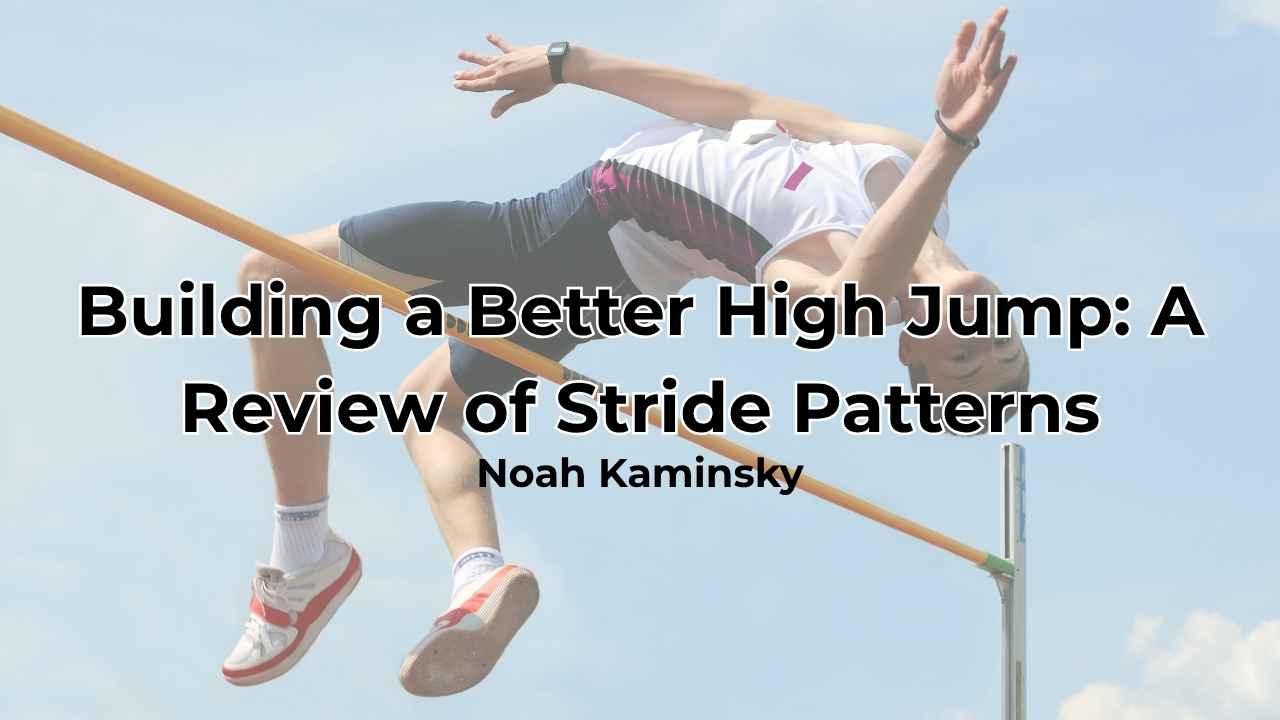[mashshare]
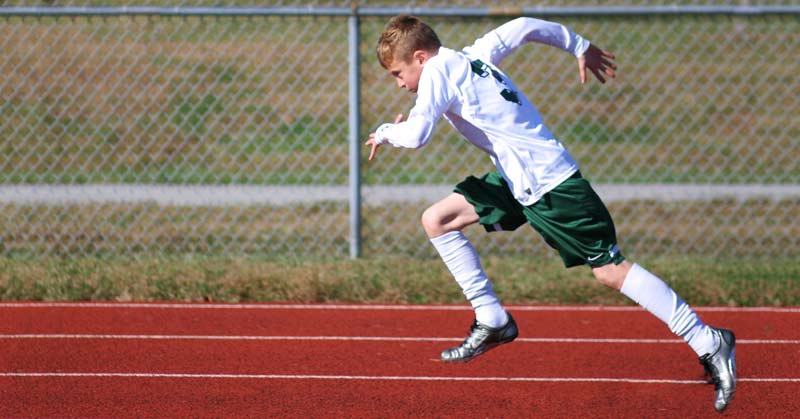
Summary
Teaching children proper sprinting technique is crucial for athletic development across many sports, noting that youth sports often neglect speed training in favor of endurance, resulting in poor mechanics.
Key takeaways include:
- Kids should practice sprinting at full speed, without a ball, ideally wearing track spikes and having their sprints timed.
- Effective sprint training involves short, intense sessions performed when the athlete is not tired, incorporating plyometrics and video feedback.
- Parents are advised to find sprint coaches who emphasize alactic (short, high-intensity) training, use timing systems, and understand correct sprint mechanics.
- The article cautions against coaches who push early sport specialization, use ineffective methods (like parachute running), or lack a track and field background.
- Improving sprint speed can significantly benefit performance in other sports, like football, as illustrated by examples in the article.
- A balanced approach is recommended, encouraging multi-sport participation alongside dedicated sprint training for overall athletic success.
Without sprint training, soccer breeds horrible sprint mechanics and slow runners. Same with football. Same with basketball. Same with baseball.
Kids need to sprint at full speed without a ball. They need to wear track spikes. If they aren’t wearing spikes, they aren’t sprinting. Sprints must be timed. Records must be kept. Every sprint must be less than five seconds in length. Any sprint more than five seconds trains something other than max-speed. Kids should perform all sprint training in a non-fatigued state. Sub-max sprinting will not make kids faster.
Sprint mechanics must be taught. Plyometrics must be included. Video must be analyzed. Rest, recovery, and growth must be respected. For optimum effectiveness, kids must sprint two or three times a week. Anything more than this is counterproductive. Less is more.
Kids Can Learn to Sprint
I’ve witnessed the evolution of sports in America. I played football, basketball, baseball, and ran track. Not once did I pay to play. I didn’t compete against teams from other towns until 7th grade. High school sports were covered by the local radio station and daily newspaper. I kept a scrapbook, not a Twitter account.
Times have changed. Youth sports have become a big deal. Parents invest. Parents strategize. Before kids learn to multiply and divide, they’re playing soccer against teams from other towns. Before kids read Charlotte’s Web, their baseball teams have traveled to out-of-state tournaments. Most boys have played football for several years before they enter high school.
Most kids learn to play their sport but never learn to sprint. Share on XWith this great interest in youth sports, you would think kids would be faster than ever. I’ve found the opposite to be true. Most kids learn to play their sport but never learn to sprint. Sprinting must be taught and practiced. This seldom happens in youth sports.
My advice to athletic-minded parents: Teach your kid to sprint.
Running is Not Sprinting
It seems all little kids play soccer these days. Soccer is an endurance sport. Typical soccer players run seven miles per match on average. Sometimes I see soccer players run faster than others, but I seldom see sprinting. Sprinting doesn’t happen during a seven-mile run. You might be the fastest slow person, but that doesn’t make you a sprinter.
No one sprints in a state of fatigue. Endurance athletes are efficient, not fast. To keep running for an extended amount of time, athletes learn to compensate to keep going. Compensations become habits.
Compensations are adjustments made, often unconsciously, to survive a task. Sprinting is never achieved in high-volume situations. Athletes instinctively switch to auto-pilot, choosing efficiency and survival. When kids compete for an hour, they’re never sprinting. They may be running relatively fast, but they’re not sprinting.

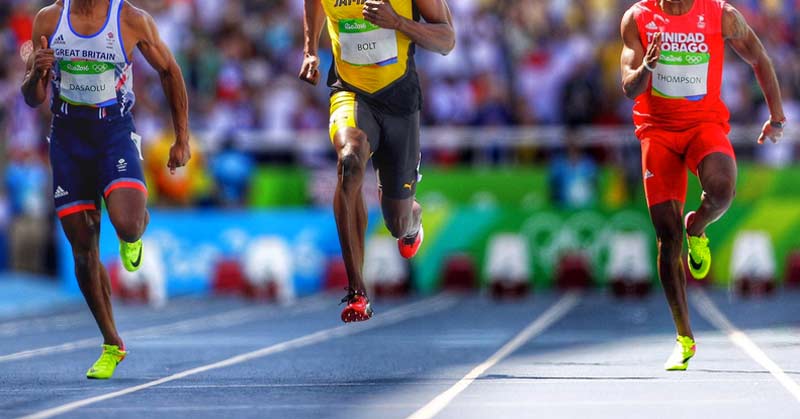
Speed Can be Taught and Learned: Clayton Lakatos, 4th Grade
Clayton Lakatos is a 75-pound 10-year-old. Clayton comes from an athletic family and has played soccer, baseball, and flag football. Sounds like your typical athletic kid.
A closer look, however, reveals Clayton is different. Clayton was taught to sprint by his dad, one of the best track coaches in the state of Illinois. Chad Lakatos coaches at Edwardsville High School. Edwardsville won the Illinois 3A (big school) title in 2015 and placed 2nd in 2012, 2014, and 2016.
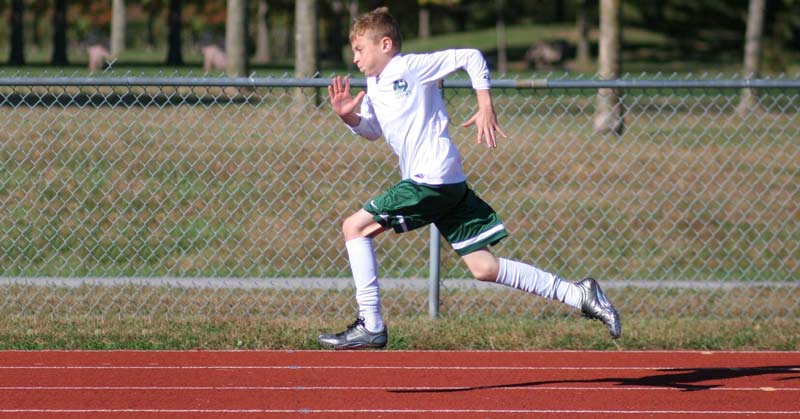
Good sprint coaches are data-driven. I have timed over 200,000 40s in my coaching career. Check out Clayton’s 40 times in the graph below.
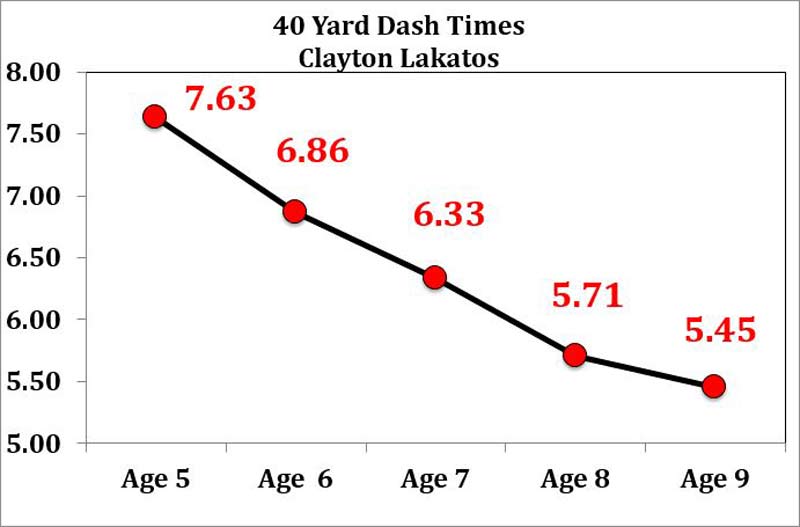
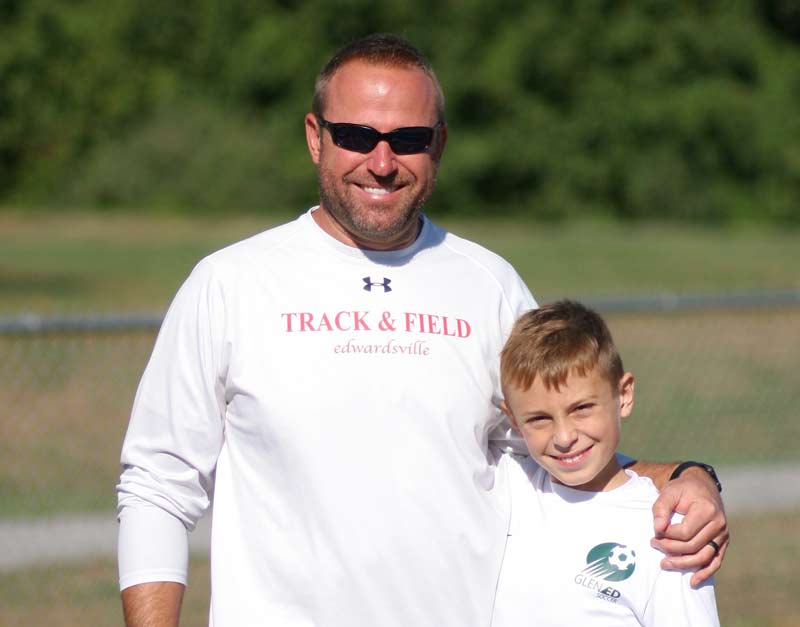
Clayton’s additional marks at age 9. All of these are sprint-dependent.
- 100m 15.2
- 200m 33.3
- 400m 1:25.4
- Long Jump 12’0”
- High Jump 4’0”
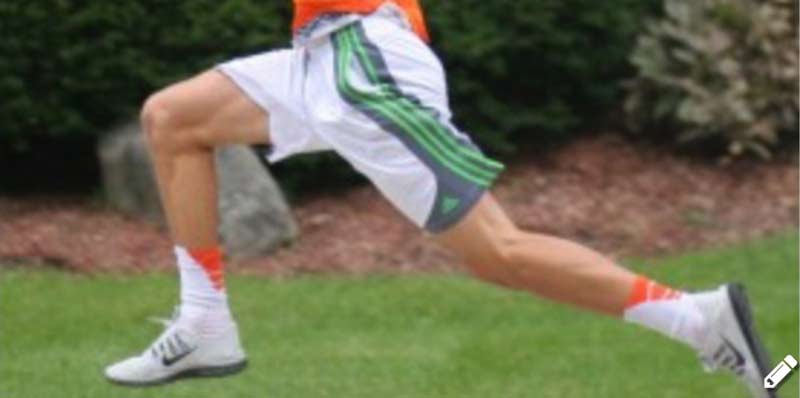
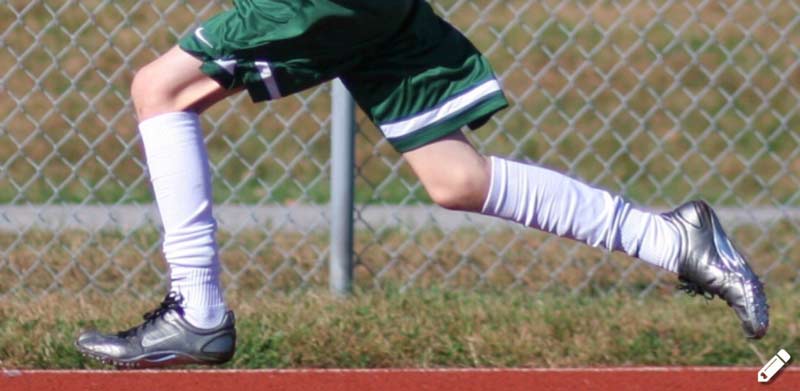
Speed Training Makes Football Players Faster: T.J. Kane, High School Athlete
T.J. Kane was a typical athletic kid. He was best at throwing and catching a football. As a freshman, T.J. was my starting quarterback for a team that went 9-0, outscoring their opponents 458-38. As a sophomore, T.J. again quarterbacked his group to a 9-0 season. Then something crazy happened. T.J. went out for the track team and got fast. T.J. is now an elite high school wide receiver and plans to play college football.
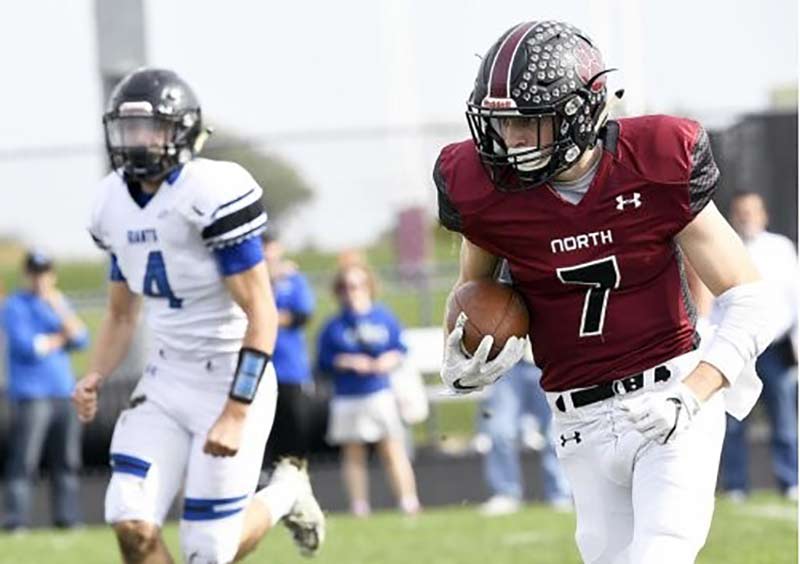
I don’t think fast was ever used to describe T.J. as a young athlete (that’s a polite way to say that T.J. was slow). He’s still not a candidate to run on my 4×1, but he sure looks fast on the football field. Based on the graphs below, we expect T.J.’s speed numbers to improve.
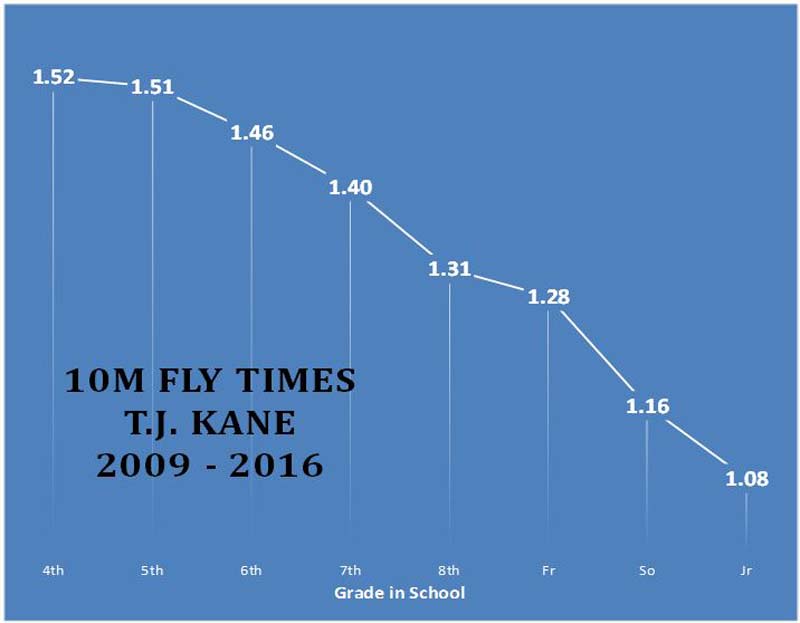
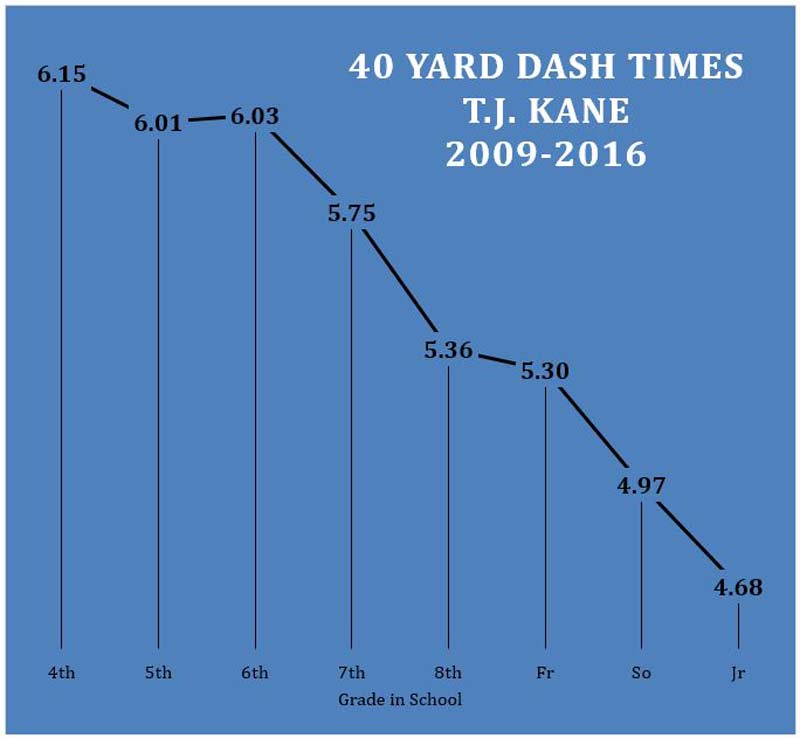
Athletes get fast when they develop good sprint habits. I believe every football player should sprint train consistently starting at the end of football, continuing through the track season, and into the summer. We are what we do.
T.J.’s dad, Tim Kane, is the head football coach at Plainfield North High School. I’ve been on Coach Kane’s football staff for eleven years. Tim has always promoted my speed training. We have our differences, but we always agree on the subject of speed. You might see this as a natural relationship between a football coach and a track coach, but it’s often the opposite. Football coaches sometimes use the term track speed as a dog whistle for wimp speed.
Last week, when I told a track coach to bring their football coach to TFC-4, the track coach replied, “We have a better chance of developing cold fusion.”
Where to Find Sprint Training
The best way to get fast is to join the track team. Competition and measured efforts take athletes to new levels. I cannot emphasize this enough.
Off-Season Speed Training: Sprint Coaching Methods to Look For
- Make sure sprinting is timed. If sprinting is not timed, it’s not sprinting. If you see a Freelap timing system, you know you’re on the right track. If you see the sprint coach meticulously recording times and giving athletes instant feedback, you have the right place.
- Look for a sprint coach who believes in alactic training. Alactic training is maximum intensity work for less than ten seconds followed by enough rest to repeat the effort on the next attempt. Mindless weight lifting, grueling aerobic workouts, and multiple repeats of 200 meters have no place in sprint training.
- If you see mini-hurdles, the coach probably knows his stuff. Wicket drills (running over mini-hurdles) is a staple of sprint training. Remember, sprinters pick up their feet, lift their knees, and then deliver vertical force.
- Look for a sprint coach whose strength training looks different than your high school football team back in the 80’s or 90’s. The old bench press, curl, and squat guys are going extinct, thankfully. By the way, sprinting is the best strength exercise I know.
- Find someone who has a true track and field sprint background.
- Video analysis is a part of every reputable sprint program. In today’s era of slow motion video on every iPhone, it’s inexcusable to train without video.
- If you see a poster saying Train Smarter, Not Harder, you’ve probably found the right place.
Off-Season Speed Training: Sprint Coaching Methods to Avoid
- If a speed coach tries to convince your kid to specialize in one sport, sever ties immediately. No entrepreneurial coach should put training in conflict with playing multiple sports.
- If you see guys running with parachutes behind them, turn around and walk out. Sprint training requires ground contact times of a fraction of a second (0.08 in elite sprinters). If you are pushing things, pulling things, running slowly uphill, or running with parachutes, your contact time won’t be 0.08. You might as well be wearing ankle weights (don’t wear ankle weights either). Note: I’m talking sprint training. Coaches will often push and pull things to train acceleration. When accelerating, ground contact times are much longer than max-speed sprinting. In my opinion, the best indicator of sprint ability is max-speed. The 10m fly is a much better predictor of success than the 10m start. Give me a guy who runs 25 mph, and acceleration will be learned quickly.
- Be cautious of speed training with ex-NFL players and ex-college athletes who failed to graduate. In my experience, these entrepreneurs attempt to use their athletic resume to hide their inexperience as coaches.
- Too many ex-football players are addicted to the grind of football training. The grind has nothing to do with sprinting. Training hard seven days a week will make athletes slow and trainers rich.
- Avoid places that advertise muscled-up athletes wearing No Pain, No Gain t-shirts with cut-off sleeves. Bodybuilding is for magazine covers, not for speed.
- If you see a sign that says, Train Insane or Remain the Same, run away.
FAQ
Why should kids learn to sprint?
Sprinting is crucial for athletic development across many sports, and youth sports often neglect speed training, leading to poor mechanics.
What are some recommended methods for teaching kids to sprint?
Kids should sprint at full speed without a ball, wear track spikes, have their sprints timed, and train with short, intense sessions when not fatigued, incorporating plyometrics and video analysis.
What kind of sprint coach should parents look for?
Parents should seek coaches who prioritize alactic training (short sprint with high-intensity), use timing systems, and understand proper sprint mechanics, preferably with a track and field background.
What kind of coaching practices should parents avoid?
Parents should avoid coaches who promote early sport specialization, use ineffective training methods (like parachute running), or lack a track and field background.
Can sprint training help in other sports?
Yes, sprint training improves athletes’ speed, benefiting their performance in sports like football.
What is the best way to start athlete training?
The best way to start athlete training is by consulting with a qualified coach to assess your current fitness level and goals. They can help create a personalized plan that includes a gradual progression of exercises, proper technique, and rest periods to prevent injury and maximize results.
How often should an athlete rest?
Rest is crucial for athletes. The frequency depends on the intensity and volume of training, but generally, incorporating at least 1-2 active recovery days and ensuring adequate sleep (7-9 hours for adults, more for younger athletes) is vital for muscle repair, energy restoration, and injury prevention.
Since you’re here…
…we have a small favor to ask. More people are reading SimpliFaster than ever, and each week we bring you compelling content from coaches, sport scientists, and physiotherapists who are devoted to building better athletes. Please take a moment to share the articles on social media, engage the authors with questions and comments below, and link to articles when appropriate if you have a blog or participate on forums of related topics. — SF
[mashshare]


